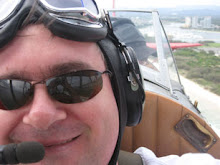Tomorrow is another week. Another fun time back at the coal face playing with the cutting edge stuff; the stuff that only a few people will actually get to, or feel obliged to, see. The fact is, compared to the mainstream media forms the stuff we do on the internet has a pretty small following. The stuff we do for Broadband connections is even smaller. But that's not the point.
Every now and again you get the chance to be a part of something that really feels like it's part of something bigger. To this end, I've had the opportunity recently to be a part of a pilot project for an enhanced online presence for one of the ABC's flagship programs. Said pilot was shown to the powers-that-be through the week and, if what I'm hearing is right, it will be unleashed upon the world tomorrow night.
I don't want to say too much because at this point I believe it still hasn't been officially announced, and for all I know between now and then sanity will ensue and we'll be given a little more time to sand off some of the rough edges before it gets its debut.
What I do want to say is this. This little project is not really groundbreaking from a user perspective. It's not in the same area as the BBC's Annotatable Audio Project I linked to last week. This is not some new and exciting way for users to interact with media. In fact, from a user's perspective it's really no more exciting and innovative than a DVD. Where this project excites me, and it's only something that I really came to understand last week as it was being demostrated, is in the creation.
The ABC does its fair share of Broadband Specials, in particular the 4 Corners specials, based in a Flash interface. If you have the time and the connection, check them out. They're really well made, solid, sturdy and really quite pretty. Where they fall down is in the time, energy and budget it takes to get them up and running.
The project I've been working on allows the program makers to start thinking about creating additional online content every week, supersizing every show they make, without the need for huge additions to staff and budgets. It's highly template based, where the standard shell sits in its spot on the web page and the producer just fill it each week with whatever's relevant and useful. With the ABC's encoding and publishing software in place all of a sudden it makes it easier to create content rather than spending time integrating and coding, and when it comes down to it people come to sites for content, not because they're well coded (but that's another argument for another time). Moreover it means that the TV editors start thinking about preparing, creating and submitting this content without making it difficult and time consuming for them. That way their part in the project doesn't just revolve around broadcast time.
I want to stop for a second and make it quite clear that my part in this has been kind of incidental. However, I'm glad to have been a part of it if only as a learning experience and to make me realise how fortunate I am to be working with some of the most innovative media professionals in the country. Congrats to Jess Daly, Martin Southgate and Tim Madden for bringing the proposal to fruition and for opening my eyes a little about what I'm part of.
[Edit]This item was held over until now because the finished product needed to be given the official thumbs up to be shown to the public. You can find the page for the "WIlliam McInnes Australian Story Special" that I'm talking about right here.
Sunday, November 06, 2005
Subscribe to:
Post Comments (Atom)


No comments:
Post a Comment